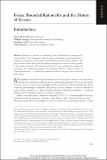For What It’s Worth: Historical Financial Bubbles and the Boundaries of Economic Rationality
Author(s)
Deringer, William P
Download683196.pdf (25.30Kb)
PUBLISHER_POLICY
Publisher Policy
Article is made available in accordance with the publisher's policy and may be subject to US copyright law. Please refer to the publisher's site for terms of use.
Terms of use
Metadata
Show full item recordAbstract
This essay is a historical and epistemological exploration of a traditionally crazy economic event: the financial bubble. Venturing into two different moments in the history of economic thinking, it investigates financial bubbles as epistemic frontiers, where rationality has reached its limits. The first half forays into late twentieth-century economics. Since 1980, an interpretive battle over the ir/rationality of bubbles has made those peculiar events, long beyond the pale of the rational, contested terrain on which the limits of rationality have been fought out. The essay’s second half turns to one historical crisis, the South Sea Bubble. For contemporaries in 1720, the bubble was a different kind of epistemic frontier. As they tried to reckon what South Sea Company stock was worth, investors were confronted not with clearly rational or irrational choices but with a decidedly unruly collection of similarly plausible calculations. The story of 1720 suggests that studying historical confusion might be a profitable enterprise for scholars of the economic and epistemological past.
Date issued
2015-09Department
Massachusetts Institute of Technology. Program in Science, Technology and SocietyJournal
Isis
Publisher
University of Chicago Press
Citation
Deringer, William. “For What It’s Worth: Historical Financial Bubbles and the Boundaries of Economic Rationality.” Isis 106, 3 (September 2015): 646–656 © 2015 The History of Science Society
Version: Final published version
ISSN
0021-1753
1545-6994